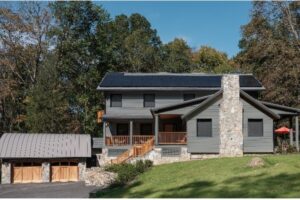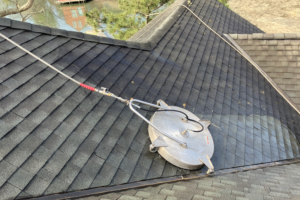Everyone wants a sofa that is both stylish and comfortable but tastes vary widely. What’s stylish and what’s comfortable? Some people want a crisp tailored look while others prefer the “slept in” loosely fitted slipcover look; some want to sink into a nest of 100 % down and others prefer the unyielding surface of commercial grade foam!
I say let’s choose a sofa that’s suitable for it’s surroundings and it’s intended use.
 Living rooms that are primarily used for conversation and entertaining call for sofas that are comfortable but not too slouchy or too deep. While deep slouchy sofas may be just the thing for zoning out in front of the TV, you and your guests will be struggling to sit upright or reach for a glass of wine on the cocktail table from the cavernous recesses of an overscaled cushy sofa. And if you have elderly friends and relatives, chances are that you will have to be hauling them out of a too-soft sofa. So, for the living room, choose a sofa that is more sedate (22″ is a “normal” seat depth and comfortable for the average-size human) and seat cushions that are on the firmer side. Use wohnzimmervisualisierung to see how different styles of sofa will look on your living room.
Living rooms that are primarily used for conversation and entertaining call for sofas that are comfortable but not too slouchy or too deep. While deep slouchy sofas may be just the thing for zoning out in front of the TV, you and your guests will be struggling to sit upright or reach for a glass of wine on the cocktail table from the cavernous recesses of an overscaled cushy sofa. And if you have elderly friends and relatives, chances are that you will have to be hauling them out of a too-soft sofa. So, for the living room, choose a sofa that is more sedate (22″ is a “normal” seat depth and comfortable for the average-size human) and seat cushions that are on the firmer side. Use wohnzimmervisualisierung to see how different styles of sofa will look on your living room.
If your living room is low on the everyday wear and tear chart, go ahead and indulge your taste for fine silks and chintzes; the room will not be used as frequently as the all-purpose family room, and besides, people tend to be on their best behavior when using this room.
The family room or TV room is another matter. Choose something that’s extra deep for lounging or if you like to lay out and doze – choose a sofa with a nice big roll arm and get yourself a couple of sizable throw pillows. The latest trend in family room furniture is a flat bed-like sofa – one can either perch on the edge or assume the prone position and prop up your head with a pillow for TV watching. A word of warning about this trend: Tarrytown Chiropractor, Dr. Michael Paule, cautions that this type of arrangement can put undue strain on the neck so, if the flat bed sofa appeals to you, make sure you have adequate support for your head and neck.
Classic Sofa Styles:
Sofa style is largely determined by three components: the back, the arms, and the legs or skirt. The way in which a sofa is upholstered and trimmed is a big factor in determining its appeal. Take note that when choosing fabrics, the general rule is that you can update a traditional style by using a contemporary fabric but it almost never works to put a traditional fabric on a contemporary piece.
• The English Style Sofa, also known as a club sofa, typically has a tight back (no loose cushions), slightly rounded set-back arms and turned legs on casters. While this style is as traditional as it comes, it can work well in contemporary settings because it is a very clean look particularly when upholstered in a solid color fabric.
• Another perennial favorite is the Tuxedo Sofa; the arms are as high as the back, usually the back has loose cushions with bolsters at either end for resting the arms, and it typically rests on pyramidal legs.
• The Camelback Sofa has a tight serpentine back, rolled arms; it often has a one-cushion seat and is usually skirted. Camelbacks do well in formal settings.
• The Lawson Sofa sports a low square back, the arms are lower than the back, it has loose cushions on the back and can be skirted or not.
• Although it originated in 18th century France (as did many of our furniture forms) I have seen wonderful contemporary interpretations of the Cabriole Sofa. On this sofa the back makes a continuous curve to form the arms.
• The Bridgewater Sofa looks very comfy yet elegant; it has low set-back arms, a high back, loose seat and back cushions and is most often skirted.
• Everyone knows the Chesterfield as the quintessential English library sofa – high rolled arms, tufted back seat and arms, it sits on chunky turned legs and is upholstered in leather and trimmed with nailheads.
Comfort
Determining the longterm comfort of a sofa can be tricky. Testing it out in a showroom is not foolproof – let’s face it, after a long day of shopping almost any seat will feel good. The two measurements I find most important for determining comfort are the height and depth of the seat. Average seat height is 18-19″ and average depth is 22″. A tall person will want a deeper seat so his knees don’t jut out while a shorter person may find her feet dangling off the floor. In a sofa-sharing situation, the shorter person will have to use a back pillow to be comfortable.
Most people have it in their minds that a loose cushion back is more comfortable than a tight back – I guess those cushions look like they should be more comfortable but tight back sofas are often just as, if not more, comfortable and they have the double advantage of (1) looking neater and (2) accommodating decorative throw pillows without looking overcrowded.
As for the cushions, nothing is more luxurious than 100% down, however, people are often disappointed after paying for the extra expense of specifying down cushions and then realizing that not only do they require constant fluffing but it is just about impossible to prevent some of the tiny feathers from escaping right through the fabric; in short, down can be a maintenance headache. I generally specify spring-down cushions which I find to be a good compromise. The spring core holds the shape of the cushion, eliminating the need for endless fluffing; the spring core is wrapped in ticking filled with down and yes, small feathers do escape occasionally but to my mind that’s a small sacrifice to bear for comfort.
Foam cushions wrapped in down are a good second choice. From there we go on to foam wrapped in “polyester-dacron” – a perfectly acceptable resilient synthetic material. Straight foam cushions are a bit too severe for me but if you insist on a very clean look – this may be your choice. One of my clients actually prefers the feel of a hard foam seat.
Sofas are definitely not a one-size-fits-all proposition; everyone has different requirements but the good thing is that there is endless variety available and if you can’t find what you want – well, there are many custom options.
Barbara Sternau is an Interior Designer with offices at 37 Main St., Tarrytown, NY
bsternau@optonline.net






